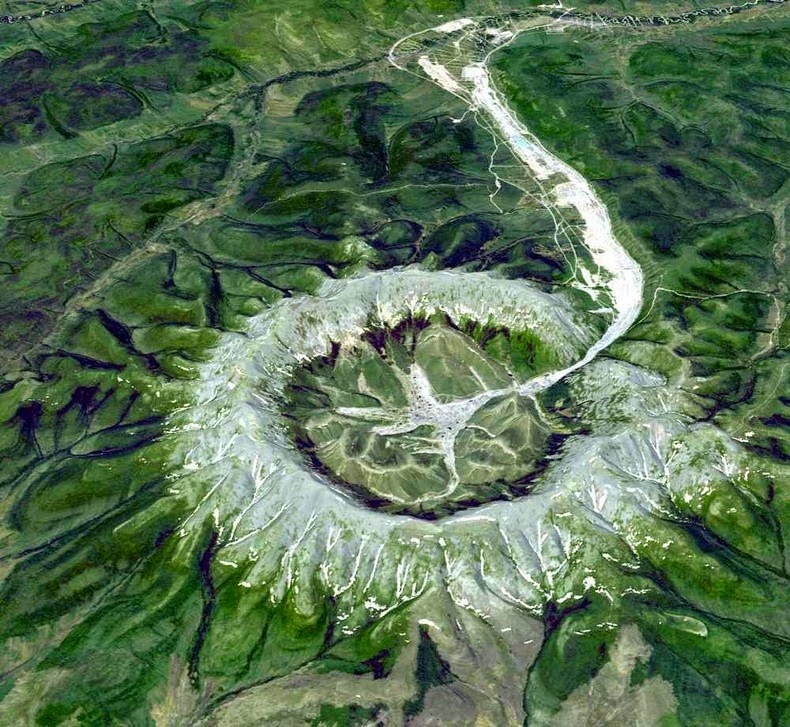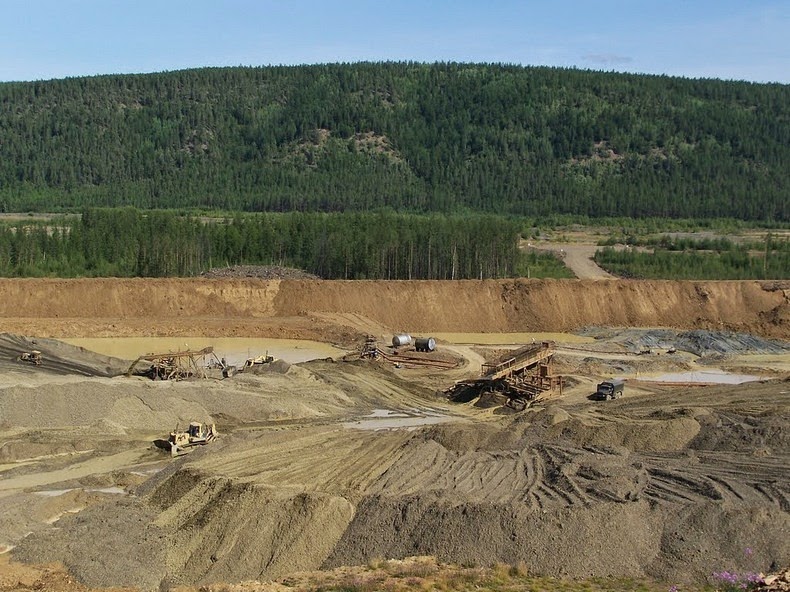Kondyor Massif of Eastern Siberia
The Kondyor Massif is a perfectly circular geological formation in
Eastern Siberia, Russia, roughly 600 km west-to-southwest of Okhotsk, or
some 570 km south-east of Yakutsk. From space it looks like an impact
crater or the caldera of an extinct volcano, but Kondyor Massif is
neither. It is what geologists refer to as an “intrusion”.
An intrusion forms when molten magma of igneous rock crystallizes below the surface of the earth, and is slowly pushed up through the earth’s mantle, a process that can take millions of years. As the rock slowly cools into a solid, the different parts of the magma crystallize into minerals. Because the magma solidify underground before they reach the surface of the crust, they are also called “plutons”, in honor of the Roman god Pluto, the king of the underworld.

Photo credit
Kondyor Massif is about 10 kilometers in diameter with ridges reaching to an height up to 600 meters. A small river, fed by rainwater collecting within the raised rim flows out of the massif through a cut in the rim. Kondyor Massif is unique not just because of its unusual structure, but for the mineral veins within it - gold, silver, platinum and lots of other rare minerals.
Kondyor Massif is an important source of platinum and is the site of a massive platinum mine. Mining started here in 1984, and till 2011 the Kondyor mine has produced about 85 tons of platinum. Another remarkable and very unusual mineralogical feature of the deposit is the presence of coarse crystals of platinum-iron alloy, coated with gold. The Kondor Massif even has its own special mineral known as Konderite, a mixture of copper, platinum, rhodium, lead, and sulfur.
Also see: Devils Tower ay Wyoming, USA, another well-known example of an intrusion

Photo credit

Photo credit

Mining sands for platinum near Kondyor Massif. Photo credit

Workers’ settlement near the mine. Photo credit

Another view of the quarries. Photo creditRetrieved from Web site: Amusing Planet
An intrusion forms when molten magma of igneous rock crystallizes below the surface of the earth, and is slowly pushed up through the earth’s mantle, a process that can take millions of years. As the rock slowly cools into a solid, the different parts of the magma crystallize into minerals. Because the magma solidify underground before they reach the surface of the crust, they are also called “plutons”, in honor of the Roman god Pluto, the king of the underworld.

Photo credit
Kondyor Massif is about 10 kilometers in diameter with ridges reaching to an height up to 600 meters. A small river, fed by rainwater collecting within the raised rim flows out of the massif through a cut in the rim. Kondyor Massif is unique not just because of its unusual structure, but for the mineral veins within it - gold, silver, platinum and lots of other rare minerals.
Kondyor Massif is an important source of platinum and is the site of a massive platinum mine. Mining started here in 1984, and till 2011 the Kondyor mine has produced about 85 tons of platinum. Another remarkable and very unusual mineralogical feature of the deposit is the presence of coarse crystals of platinum-iron alloy, coated with gold. The Kondor Massif even has its own special mineral known as Konderite, a mixture of copper, platinum, rhodium, lead, and sulfur.
Also see: Devils Tower ay Wyoming, USA, another well-known example of an intrusion

Photo credit

Photo credit

Mining sands for platinum near Kondyor Massif. Photo credit

Workers’ settlement near the mine. Photo credit

Another view of the quarries. Photo creditRetrieved from Web site: Amusing Planet